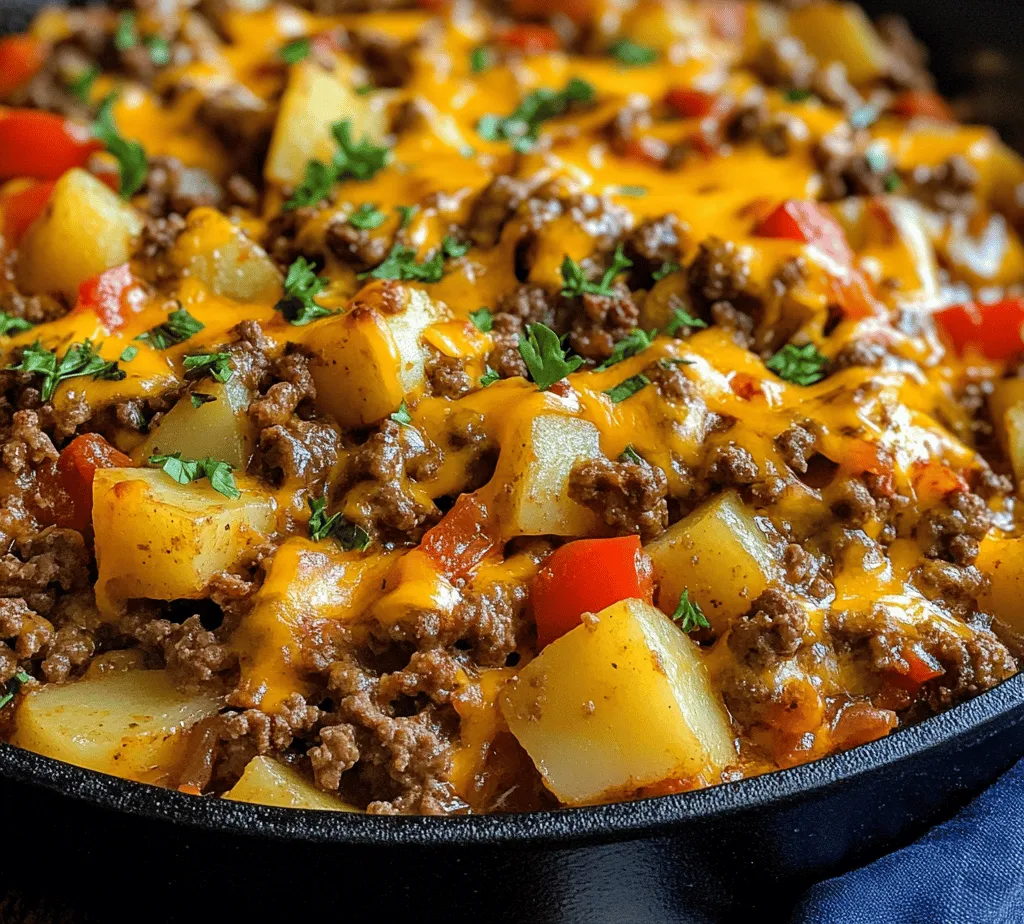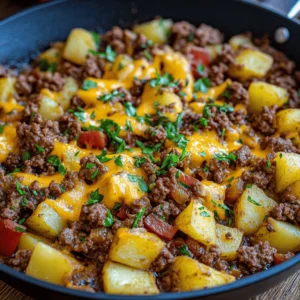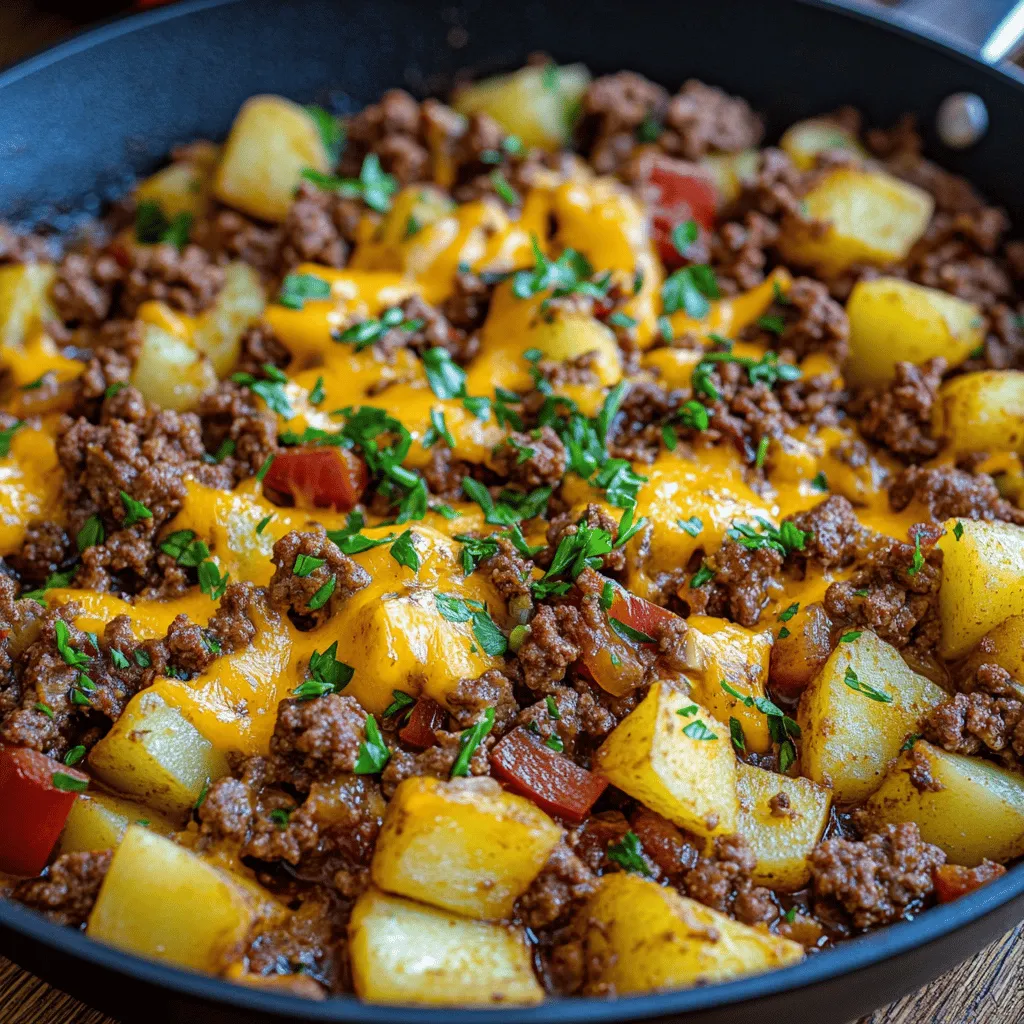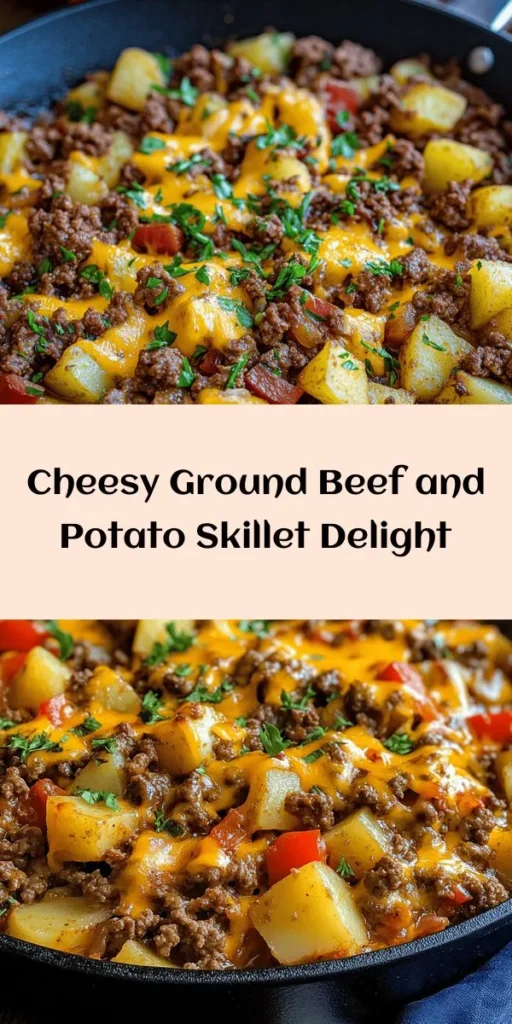Introduction
In the world of comfort food, few dishes can rival the hearty combination of ground beef and potatoes. This recipe, “Ground Beef and Potatoes: An Organized Chaos,” brings together simple ingredients to create a satisfying meal that warms the soul. Perfect for busy weeknights or a weekend gathering, this dish is not only easy to prepare but also filled with flavors that appeal to all ages.
Ground beef and potatoes have long held a cherished place in kitchens around the globe. From classic American casseroles to hearty Irish shepherd’s pies, the duo has proven its versatility and ability to comfort. This recipe takes the essence of these traditional dishes and adds a modern, organized twist to ensure a delightful culinary experience. With its rich flavors and nourishing ingredients, this meal is bound to become a staple in your household.
The Appeal of Ground Beef and Potatoes
The combination of ground beef and potatoes resonates with many for several reasons. First and foremost, it is a staple in various cuisines, each bringing its unique flair to the table. In Mexican cuisine, for example, you might find ground beef in tacos paired with roasted potatoes, while in Eastern European traditions, it can be seen in comforting stews or baked dishes. This global appeal speaks to its universal nature; it’s a dish that can be easily adapted to incorporate regional flavors and personal preferences.
Beyond its widespread popularity, the nutritional benefits of ground beef and potatoes make this dish an appealing choice for families. Ground beef is an excellent source of protein, which is essential for building and repairing tissues in the body. It also provides important nutrients like iron and vitamin B12, contributing to overall health and energy levels. Potatoes, on the other hand, are rich in carbohydrates, providing a great source of energy, and they are loaded with fiber, vitamins, and minerals. This combination ensures that you are not only satisfying your taste buds but also nourishing your body.
One of the most remarkable aspects of this dish is its versatility. The base ingredients can be complemented by a variety of additions, allowing for endless adaptations. For instance, you can incorporate different vegetables like carrots or peas for added color and nutrition. You can also experiment with spices and herbs to create a flavor profile that suits your palate. The beauty of “Ground Beef and Potatoes: An Organized Chaos” lies in its ability to transform based on what you have on hand, making it a perfect choice for using up leftovers or seasonal produce.
Ingredients Breakdown
To achieve the perfect balance of flavors and textures in “Ground Beef and Potatoes,” each ingredient plays a critical role. Here’s a detailed overview of the main components that make up this hearty dish:
– Ground Beef: As the protein source and flavor foundation, ground beef is the star of the dish. It provides a savory richness that pairs beautifully with the creamy texture of the potatoes. Opt for lean ground beef to reduce excess fat and enhance the health factor of the meal.
– Potatoes: The heartiness and texture enhancer, potatoes are what make this dish comforting. They absorb the flavors of the beef and seasonings, providing a satisfying bite. Choose starchy varieties like Russets or Yukon Golds for the best results, as they become fluffy when cooked.
– Aromatics: Onions, garlic, and bell peppers add depth of flavor and aroma to the dish. Sautéing these ingredients before adding the beef helps to release their natural sweetness, creating a flavorful base.
– Seasonings: Worcestershire sauce, paprika, thyme, salt, and pepper work together to elevate the flavor profile of the dish. Worcestershire sauce adds a subtle tanginess, while paprika offers warmth and depth. Thyme contributes an earthy note, while salt and pepper are essential for bringing out the natural flavors of the ingredients.
– Cheese: Adding richness and creaminess to the dish, cheese can take it to the next level. Cheddar is a popular choice, offering a sharp flavor that complements the savory elements. For a creamier texture, consider using a blend of cheeses or even a dollop of sour cream before serving.
– Olive Oil: Used for cooking and flavoring the beef and vegetables, olive oil is a healthier fat option that enhances the overall taste of the dish. It also helps to achieve a nice browning on the beef and aromatics.
– Fresh Parsley: As a garnish, fresh parsley adds a pop of color and a hint of brightness. It not only enhances the presentation but also offers a fresh herbal note that balances the richness of the dish.
Preparation Steps
To ensure a successful cooking experience, preparation is key. Here’s a step-by-step guide to preparing “Ground Beef and Potatoes,” making the process as clear and efficient as possible:
Ingredient Prep
Before you start cooking, gather all your ingredients and prepare them for use. Start by washing the potatoes thoroughly to remove any dirt. Depending on your preference, you can peel them or leave the skin on for added texture and nutrients. Once washed, dice the potatoes into even-sized pieces to ensure they cook uniformly.
Next, chop the onion, garlic, and bell peppers. Dicing them into small pieces will help them cook quickly and integrate seamlessly into the dish. Make sure to have all your ingredients measured and ready to go. This organized approach not only streamlines the cooking process but also helps prevent any last-minute scrambling.
Cooking the Ground Beef
In a large skillet or frying pan, heat a tablespoon of olive oil over medium-high heat. Once the oil is hot, add in the ground beef. Using a wooden spoon or spatula, break the meat apart as it cooks, allowing it to brown evenly. Browning the beef enhances its flavor and gives the dish a rich, savory base.
As the beef cooks, make sure to drain any excess fat that accumulates in the pan. This step is crucial for maintaining a balanced flavor and texture in the final dish. If you prefer a leaner option, you can choose to use extra-lean ground beef to start with, thus minimizing the need for draining.
Sautéing Aromatics
Once the beef is nicely browned, it’s time to add the aromatic vegetables. First, toss in the diced onions. Stir them into the beef and let them cook for about 2-3 minutes until they become translucent. This process helps to release their natural sweetness, enhancing the overall flavor of the dish.
Next, add the minced garlic and bell peppers. Sauté these ingredients for an additional 1-2 minutes, allowing their flavors to meld with the beef. Be careful not to burn the garlic, as it can become bitter if overcooked. The goal is to achieve a fragrant, flavorful base that will elevate the entire dish.
With the ground beef and aromatics prepared, you are well on your way to creating a comforting and delicious meal that embodies the essence of “Ground Beef and Potatoes: An Organized Chaos.” In the next part of this article, we will delve into the remaining steps to complete this satisfying dish, ensuring that every bite is packed with flavor and heartiness. Stay tuned for the continuation of this culinary journey!

Incorporating Vegetables: Timing and Techniques for Adding Bell Peppers and Potatoes
In the heart of “Ground Beef and Potatoes: An Organized Chaos,” vegetables play a crucial role in enhancing the dish’s flavor and nutritional profile. To ensure that bell peppers and potatoes are cooked to perfection, timing is everything. Start by chopping your bell peppers into bite-sized pieces. When the ground beef is nearly browned, add these vibrant vegetables to the skillet. This allows them to soften just slightly while still retaining some crunch, contributing a refreshing texture to the dish.
The potatoes should be added after the bell peppers have had a chance to cook for a few minutes. This staggered approach ensures that the potatoes get enough cooking time to become tender without turning mushy. Cut the potatoes into uniform pieces, ideally about 1-inch cubes, to promote even cooking. If you’d like to elevate the flavor profile, consider briefly sautéing the potatoes in the same pan after browning the beef before adding them back in for the simmering phase.
Flavoring the Dish: Methods to Ensure Even Distribution of Seasonings
Seasoning is the secret weapon that transforms your ground beef and potatoes into a flavor-packed masterpiece. To achieve an even distribution of seasonings, start by seasoning the beef with salt and pepper as it browns. This foundational seasoning allows the meat to absorb flavors right from the start.
Once you add the bell peppers and potatoes, sprinkle in your preferred herbs and spices, such as garlic powder, onion powder, paprika, and Italian seasoning. A mixture of these seasonings can create depth and complexity in the dish. To ensure even distribution, consider mixing the seasonings in a small bowl before adding them to the pan. This method prevents clumping and allows for a more uniform flavor throughout the dish. Incorporating fresh herbs like parsley or cilantro at the end adds a burst of freshness and color.
Simmering for Perfection: Understanding the Simmering Process for Tender Potatoes
Simmering is a critical step that elevates the quality of your dish. After the beef and vegetables are well combined, add enough broth or water to cover the mixture and bring it to a gentle simmer. This process allows the flavors to meld together beautifully and ensures that the potatoes cook thoroughly.
Maintain a low simmer, which is characterized by small bubbles gently rising to the surface, as opposed to a rolling boil. This prevents the potatoes from breaking apart and becoming overly mushy. Depending on the size of your potato cubes, simmering should take around 15 to 20 minutes. Check for doneness by piercing a potato with a fork; they should be tender but still hold their shape.
Melting Cheese: Techniques for Achieving the Perfect Cheesy Top
No dish is complete without a decadent layer of melted cheese, and achieving that perfect cheesy top is an art. After the simmering process is complete, remove the skillet from heat and sprinkle a generous layer of shredded cheese over the top. Cheddar, Monterey Jack, or a blend of cheeses works beautifully here.
To melt the cheese effectively, cover the skillet with a lid. This traps the heat and steam, allowing the cheese to melt evenly without burning. If you prefer a crispy topping, you can also transfer the skillet to a preheated broiler for a minute or two. Just keep a close eye on it to prevent burning. The result will be a rich, gooey layer of cheese that pulls apart beautifully with each serving.
Cooking Techniques and Tips
Sautéing vs. Stir-frying: Differences and When to Use Each Method
Understanding the difference between sautéing and stir-frying can enhance your cooking skills and improve your dish’s final result. Sautéing involves cooking food quickly in a small amount of oil over medium to high heat, allowing for browning and flavor development. This method is perfect for browning ground beef and softening vegetables in our recipe.
On the other hand, stir-frying typically requires higher heat and constant motion, making it ideal for quick-cooking smaller pieces of food, such as julienned vegetables. While both methods can be used in our dish, sautéing is preferred for the initial browning of the beef and vegetables, ensuring that each ingredient is cooked through and evenly flavored.
The Importance of Simmering: Ensuring Flavors Meld and Potatoes Cook Thoroughly
Simmering is not just a cooking technique; it’s a crucial step in flavor development. By allowing the ingredients to simmer together, the flavors blend seamlessly, creating a cohesive taste throughout the dish. Additionally, this method ensures that the potatoes absorb the savory broth or seasoning, enhancing their flavor profile.
As mentioned earlier, keeping the simmer at a low temperature allows for the potatoes to cook evenly without disintegrating. It’s essential to stir occasionally to prevent any sticking and to ensure that all ingredients are immersed in the flavorful liquid.
Cheese Melting Techniques: Best Practices for Avoiding Clumping or Burning
To avoid clumpy or burnt cheese, it’s essential to choose the right cheese and apply the proper technique. Opt for freshly shredded cheese instead of pre-shredded options, as the latter often contains anti-caking agents that can affect meltability.
When adding cheese, consider the skillet’s residual heat. The cheese should be added as the dish is coming off the heat to allow for gentle melting. Covering the skillet helps create a steamy environment. If using a broiler, keep the skillet close to the heat source and monitor it closely to achieve that golden, bubbly finish without burning.
Serving Suggestions
Ideas for Plating the Dish Attractively
Presentation is key when serving “Ground Beef and Potatoes.” Consider using a large, shallow serving dish to showcase the colorful layers of the dish. Garnish with freshly chopped herbs like parsley or chives to add a pop of color and freshness.
For a rustic touch, serve the dish directly from the skillet if it’s oven-safe, allowing guests to help themselves. Pair with a side of crusty bread or a light green salad to balance the meal visually and nutritionally.
Pairing with Sides: Suggestions for Complementary Dishes or Salads
To round out your meal, consider pairing “Ground Beef and Potatoes” with light and refreshing sides. A simple mixed green salad with a tangy vinaigrette can provide a crisp contrast to the richness of the beef and cheese. Alternatively, roasted or steamed vegetables, such as broccoli or green beans, add vibrant color and additional nutrients.
For a heartier option, serve with garlic bread or a cheesy breadstick, which can help soak up any delicious sauce left on the plate.
Beverage Pairings: Recommended Drinks to Enhance the Meal Experience
Choosing the right beverage can elevate your dining experience. A full-bodied red wine, such as Cabernet Sauvignon or Merlot, complements the savory flavors of the beef beautifully. For those preferring non-alcoholic options, a refreshing iced tea or sparkling water with lemon can cleanse the palate between bites.
If you’re serving this dish at a family gathering, consider offering a selection of beverages, including soft drinks or homemade lemonade, to cater to different preferences.
Portioning: Tips on Serving Sizes for Families or Gatherings
When serving, consider the size of your gathering. For a family meal, serving sizes of about 1 to 1.5 cups per person is often adequate, depending on individual appetites. If you’re hosting a gathering, consider using a buffet-style setup where guests can serve themselves, allowing for flexibility in portion sizes.
Keep in mind that this dish tends to be filling due to its hearty ingredients, so be mindful of portions to avoid waste. Providing smaller serving options can encourage guests to try more sides or take seconds without overindulging.
Nutritional Information
Caloric Breakdown per Serving: Understanding Calories from Beef, Potatoes, and Cheese
Understanding the caloric content of your meal is essential for making informed dietary choices. A typical serving of “Ground Beef and Potatoes” contains approximately 500-600 calories, depending on the amount of cheese and fat content in the ground beef used. Ground beef, while a good source of protein, also contributes significantly to the caloric content, especially if using higher-fat blends.
Potatoes add carbohydrates and fiber, making them a filling component of the dish. The cheese not only enhances flavor but also adds extra calories, so adjust the amount based on your dietary goals.
Macronutrient Profile: Protein, Carbohydrates, and Fats
In terms of macronutrients, this dish typically provides a balanced profile. A serving can offer around 30 grams of protein from the beef and cheese, 40 grams of carbohydrates from the potatoes, and approximately 20-30 grams of fat, largely dependent on the beef’s fat content and the amount of cheese added.
This balance makes it a satisfying meal, but those monitoring their fat intake may opt for leaner beef and reduced-fat cheese options to maintain the dish’s integrity while aligning with dietary preferences.
Health Considerations: Discussing the Balance of the Meal and Potential Modifications for Dietary Restrictions
While “Ground Beef and Potatoes” is comforting and delicious, it’s essential to consider dietary modifications for guests with specific health needs. For a lower-calorie version, using lean ground turkey or chicken can significantly reduce fat content while still providing protein.
For those following a vegetarian or plant-based diet, substituting the beef with lentils or a plant-based ground meat alternative can create a similar texture and flavor while catering to dietary restrictions. Additionally, using sweet potatoes instead of regular potatoes can offer added nutrients and a slightly different flavor profile.
Conclusion
“Ground Beef and Potatoes: An Organized Chaos” is more than just a meal; it’s a comforting dish that brings people together. With its easy preparation and rich flavors, it’s a perfect fit for any dining occasion. This recipe not only satisfies hunger but also nurtures a sense of warmth and togetherness, making it a timeless addition to any home-cooked repertoire. Whether enjoyed on a busy weeknight or as a cozy family meal, this dish is sure to become a favorite in your culinary collection.
Embrace the organized chaos of this recipe, and let it inspire you to explore your creativity in the kitchen while leaving a lasting impression on your family and friends.



